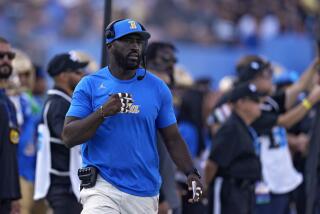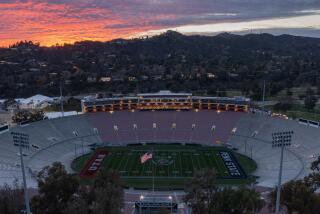COLLEGE FOOTBALL BOWL GAMES : Southern California Canât Lose Its Rose Bowl Roots
OK, take a hike 1995! Gidouddahere! And take the Rams and Raiders with you!
So we lost the Rams and Raiders. Lost our innocence. But hold the flowers. Put away the handkerchiefs. Stop the sobbing.
We still have the Rose Bowl, donât we?!
You know, ask anybody back in the â20s what came to mind when they thought about L.A. and the answer would come back without hesitation, âCharlie Chaplin and the Rose Bowl!â
It was that indigenous a part of the lore of the region, even of the country. It was here before all the Blockbuster bowls, John Hancock bowls, Weedeater bowls and Fiesta bowls.
Pretty much the whole nation tuned into the Rose Bowl on the crystal sets of early radio at the time. It was the only game in town.
It was the most prized invitation this side of the White House. Coaches lusted to get to the Rose Bowl. They stepped up their cheating to get there. Networks vied to broadcast it.
It played its part in making Southern California a mecca for the restless. There was no television in the early days, but the nation saw newsreels of football fans sitting in their shirt sleeves sipping orangeade. On a day when the wind-chill factor at home in Duluth was probably a minus-20. It was, What Are We Doing Here In Galoshes And Earmuffs?
It almost never rained on a Rose Bowl. It was as if nature were in on the conspiracy. Oh, it rained in 1934 when an undermanned Columbia upset the mighty Vow Boys of Stanford (they had vowed never to lose to USC), 7-0, in a quagmire. It rained in 1955 when a Woody Hayes Ohio State team that moved up several lengths in the heavy going beat SC, 20-7. Thatâs the last time it rained on New Yearâs.
The Rose Bowl had a partner. The Rose Parade annually dazzled more than 1 1/2 million spectators--and tens of millions of others when TV arrived on the scene.
But, as Shakespeare said, the play was the thing. And the Rose Bowl contributed more than rose petals. Its games went into the lore of college football.
One of the most famous football incidents of all time took place in the 1929 game when Roy Riegelsâ name went into the language after he ran the wrong way with the football. Such was the impact of the Rose Bowl--he never lived it down. The Rose Bowl was the wrong place to make a mistake. The whole world was looking on--or listening in. If he did it against Oregon State, no one would ever know. But in the Rose Bowl against Georgia Tech, it was Page 1 stuff.
The historic 1939 game when a fourth-string quarterback, Doyle Nave, came on late in the game to pass for the game-winning touchdown with 41 seconds to play. That was the only score that the USC opponent, Duke, had given up that season. The Blue Devils came to the Rose Bowl undefeated, untied and unscored upon, and went 59 minutes 19 seconds before losing 7-3, ending a season in which they had been 9-0 and the point total was 114-0.
The Four Horsemen played in the Rose Bowl. In 1925, they beat Ernie Neversâ Stanford team, 27-10. Notre Dame wasnât âthe Fighting Irishâ in those days. It was âthe Ramblersâ in honor of Coach Knute Rockneâs always having his teams on a train going somewhere to spread the gospel of the Notre Dame shift.
For a football player to play the Rose Bowl was like an actor playing the Old Vic or a tenor the Met or a vaudevillian Broadway. It certified you.
The Rose Bowl was the first to call attention to the prowess of West Coast football. Oh, the annual SC-Notre Dame game helped, but it was in the Rose Bowl that the Coast pride and joy, the USC Trojans, really flexed their muscles. They clobbered the Eastern championship team, Pittsburgh, 47-14, in 1930 and 35-0 in 1933.
A âRose Bowlâ game was played in Durham, N.C., once. The war was on and the authorities feared attracting Japanese bombers.
After the war, it was the Rose Bowl that alerted the Coast that its game was hopelessly behind the times.
What happened was, an Alabama team came to Pasadena in 1946 and made a USC team look like a bunch of butlers. The score was 34-14 but it could have been worse. Consensus was the Alabama coach held the score down because he wanted to get invited in the future.
He never would. Because the Rose Bowl--by now beset by a bunch of competing bowls--entered into a pact with the Big Ten in 1947.
It made sense. Two out of three Southern Californians seemed to come from the Midwest. âL.A. was settled by a slow leak in Iowa,â was the gag of the times.
But the Big Ten teams were even further ahead than the Southern teams. The first game played under the pact ended up Illinois 45, UCLA 14. The second ended up Michigan 49, USC 0.
The West Coast was mortified. But what had happened was that Coast football, largely inspired by Howard Jonesâ great Trojan teams, had relied on crunching power. âThe Thundering Herd,â the press dubbed them. They bulldozed you. They picked the biggest, strongest farm boys and suited them up and told them, âJust donât eat anybody.â A game was a dock rumble.
But after the war, the game had subtly changed. T-formations, I-formations, split formations had come in, replacing the variants of the single-wing Neanderthal attack. The emphasis was not on brute strength, it was on speed. All that strength was wasted if you couldnât catch anybody to use it on.
The West Coast, of course, adjusted. But it was 1953 before a Pacific Coast team won. USC beat Wisconsin, 7-0. In time, the pendulum swung. One game, I remember stumbling on Sid Hartman, the Minnesota sportswriter gloomily surveying the field at halftime. âThe Big Ten is sunk, â he predicted. âIn the Big Ten, when Corny Green [Ohio State quarterback] rolls out, he helps himself to 10-15 yards. Here, he gets out there, the SC tackle is waiting for him. The tackleâs faster than he is.â
So it went. The Rose Bowl was put together by men of skill, enthusiasm and imagination and has enriched our lives. Itâs still here.
You think Northwestern isnât happier to be here than Orlando, or Miami, New Orleans or Tampa? Itâs a part of the oldest and most honorable of football traditions. The Rose Bowl.
And, itâs not going anywhere.
More to Read
Go beyond the scoreboard
Get the latest on L.A.'s teams in the daily Sports Report newsletter.
You may occasionally receive promotional content from the Los Angeles Times.










